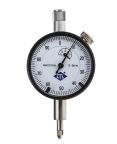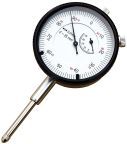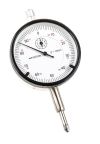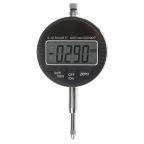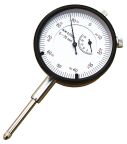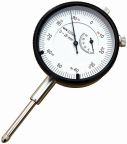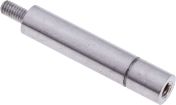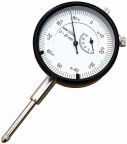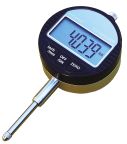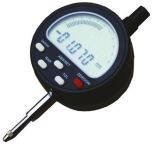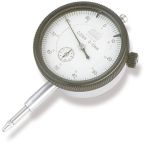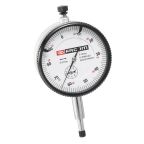- Automation & Control Gear
- Cables & Wires
- Enclosures & Server Racks
- Fuses & Circuit Breakers
- HVAC, Fans & Thermal Management
- Lighting
- Relays & Signal Conditioning
- Switches
- Batteries & Chargers
- Connectors
- Displays & Optoelectronics
- ESD Control, Cleanroom & PCB Prototyping
- Passive Components
- Power Supplies & Transformers
- Raspberry Pi, Arduino, ROCK, STEM Education & Development Tools
- Semiconductors
Dial Indicators
A dial indicator is a precision instrument used in industrial settings to amplify and measure small linear distances and variations. It translates the displacement of a contact plunger or lever into a magnified rotation of a needle on a calibrated dial, enabling precise comparison against a reference standard.
This tool is fundamental for quality control, machine setup, and component inspection, offering immediate visual feedback for assessing geometric forms like flatness, concentricity, and alignment.
Benefits of Dial Indicators
Dial indicators are essential for maintaining strict dimensional control in precision engineering and quality assurance. Their practical advantages directly enhance workshop efficiency and manufacturing quality.
- High Accuracy: Engineered for repeatable measurements with resolutions as fine as 0.001 mm, enabling the detection of minute deviations for critical tolerance checks.
- Immediate Feedback: The analogue dial provides an intuitive, real-time display of deviation, facilitating rapid adjustments and go/no-go assessments.
- Durability: Robustly constructed from hardened materials, mechanical indicators withstand harsh workshop environments, including exposure to debris and coolants.
- Versatility: Adaptable to a vast range of tasks, from checking shaft run-out to verifying surface flatness, using various contact points and mounting hardware.
- Cost-Effectiveness: Offers a reliable and accurate measurement solution at a low capital cost, with minimal maintenance requirements.
Types of Dial Indicators
Dial indicators are primarily defined by their mechanical construction. The main configurations, plunger and dial test indicators, are selected based on the specific measurement task and accessibility constraints.
Plunger Dial Indicator
Also known as a dial gauge, this type features a plunger that moves in a linear path, perpendicular to the dial face. It is ideal for direct, single-axis displacement measurements and typically offers a longer measurement range. Dial gauge indicators are the standard choice for general-purpose tasks like gauging feature height or depth.
Dial Test Indicator
A dial test indicator (DTI) uses a pivoting lever and stylus, allowing it to take measurements in locations inaccessible to plunger types, such as inside bores. DTIs are highly sensitive and are primarily used for precision alignment and setup tasks, including centering workpieces and checking for surface run-out.
How Dial Indicators Work
Dial indicators operate by mechanically or electronically amplifying the small linear movement of a contact point for display.
Mechanical
A mechanical dial gauge indicator uses a rack-and-pinion gear system. The plunger's linear motion drives a rack, which engages a series of magnifying pinion gears. The final gear moves the needle on the dial, providing a visual representation of the displacement. This purely mechanical system is robust and requires no external power.
Digital
A digital dial indicator uses an electronic linear encoder (e.g., capacitive) to detect the plunger's position. This signal is converted into a numerical value and shown on an LCD screen. Digital dial gauge models offer features like unit conversion (metric/imperial), zero setting at any point, and data output for statistical process control (SPC).
Common Applications of Dial Indicators
Dial indicators are fixtures in industrial metrology, used for comparative measurements to ensure components meet design specifications.
- Machine Tool Alignment: Tramming milling machine heads and aligning lathe tailstocks to ensure perpendicularity and concentricity.
- Shaft Inspection: Measuring radial run-out and axial end-play on rotating components to verify correct assembly of shafts and bearings.
- Surface Verification: Traversing across a surface to detect variations in flatness or straightness on machine beds and reference plates.
- Geometric Checks: Verifying the concentricity of bores or the parallelism between two surfaces within specified tolerances.
- Quality Control: Used in inspection fixtures for rapid go/no-go gauging of manufactured parts against a master component.
How to Choose the Right Dial Indicator
Selecting the correct dial indicator requires assessing the application's specific technical demands. Key factors include the measurement range, required accuracy, and the environment.
- Range and Resolution: The indicator's range must exceed the expected dimensional variation, while its resolution (e.g., 0.01 mm) should be fine enough to detect the specified tolerance.
- Accuracy: The instrument's stated accuracy must align with the tolerance requirements of the part being measured.
- Dial Size: The dial must be clearly legible in the workspace to prevent reading errors.
- Type (Mechanical vs. Digital): Choose a robust mechanical indicator for general workshop use or a digital model for applications requiring data output, high resolution, and error-free reading.
- Environment: For environments with exposure to dust or fluids, select an indicator with an appropriate IP (Ingress Protection) rating.
How to Order Dial Indicators from RS Hong Kong
RS Hong Kong supplies a wide range of precision dial indicators from leading brands. Customers can use the filtering tools on our website to select by technical specifications such as range, resolution, and type. Detailed datasheets are provided for each product. Business account holders can place orders online or contact our sales team for streamlined procurement.
The Leading Supplier and Distributor of Dial Indicators in Hong Kong
RS is your trusted source for high-precision dial indicators. We carry an extensive selection from industry-leading brands such as Moore & Wright, Mitutoyo, and RS PRO. Our inventory includes numerous types and resolutions at competitive prices, ensuring you can acquire the ideal indicator for your specific metrology application.
We also stock other precision measurement tools and accessories, such as micrometers, depth gauges, and thickness gauges, to support a wide range of inspection needs. Purchase your plunger dial indicators, dial test indicators, digital indicators, and other metrology instruments online today. For complete details on our ordering process and delivery services, please visit our delivery information page.
